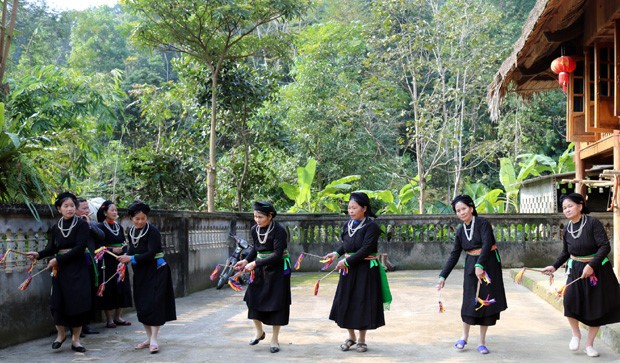(VOVWORLD) - More than 90% of the population of Xuan Giang commune in Ha Giang province is Tay ethnic minority people. Local authorities have established Folk Artisans’ Associations to preserve and develop their traditional cultural identities, especially as it relates to folk melodies and musical instruments.

Tay ethnic people in Xuan Giang commune, Quang Binh district, Ha Giang province (Photo: baohagiang)
|
Then singing, Yeu singing, and call-and-response singing hold many spiritual and societal values and are among the cultural treasure troves preserved by the Tay ethnic group in Xuan Giang commune, Ha Giang province.
Village boys and girls attend festivals like the Long tong, or Going to the field festival, and the full moon festivals in the first or the seventh lunar month, to have fun and find friends with whom to perform call-and-response singing or singing of folk melodies.
On that day, many adults and children gathered in the spacious stilt house of Mr. Hoang Van Binh, Chairman of Xuan Giang commune Folk Artisans Association, to learn singing and playing musical instruments.
Bính said the Association was established in 2012 with more than 30 members. A majority of them are village patriarchs who still remember traditional folk melodies and traditional crafts. To date, the number of members has increased to nearly 100, living in nine surrounding hamlets. Every month, in addition to teaching traditional craftsmanship, artisans also teach singing and dancing.
Binh explains how local folklore is being preserved of Quyen hamlet, Xuan Giang commune, said: “Then singing, Yeu singing, and call-and-response singing as well as traditional musical instruments have faded much over the years. It’s time to revive these art forms, and fill them with new vitality. To date, many aspects of the Tay people’s cultural identities are being maintained by households in Xuan Giang commune.”
The communal Folk Artisans Association has organized courses to teach singing and dancing at schools, especially during summer vacations.
Each class has about 40 child participants, said Mr. Binh, adding: “Folk melodies of the Tay ethnic people are rich and diverse. Folk singing or flute playing accompany traditional dances. Each dance needs a song in accompaniment.”
Hoang Thi Thap of Quyen hamlet said although the association doesn’t have an operating expenditure, the artisans by virtue of their passion and enthusiasm have arranged by themselves free classes for children to learn singing and dancing.
She said: “When I was 15 years old, I began to learn to sing and have since participated in art performances in the locality. Later I learned to dance, and joined the local art troupe and performed in various communes. Now we have a folk art troupe to exchange with other localities. This practice helps artisans like me to have an opportunity to pass down our rich tradition to the younger generation. I have taught many courses in the Xuan Giang Secondary School.”
16-year-old Hoang Thi Nhu Quynh of Quyen hamlet said she and other local children feel enthusiastic about discovering the traditional culture.
Quynh said: “I began to learn singing at the age of 13 and have performed in a variety of places. I have also participated in many local competitions and festivals. After being taught by artisan Hoang Van Binh for 3 years, I can now sing Then and folk songs. I feel honored to be a Tay person and to have had the chance to preserve the valuable folk melodies of my group.”